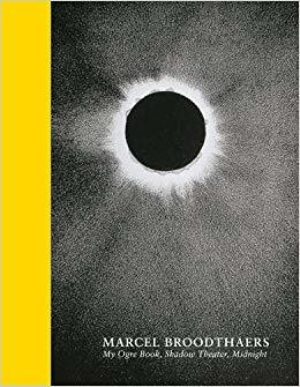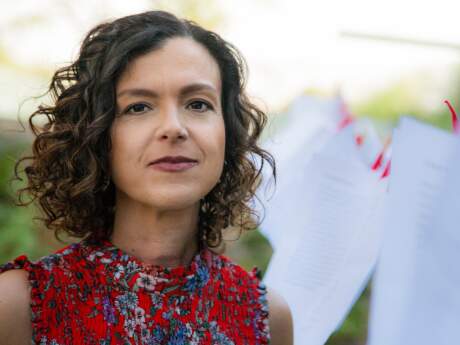In Their Own Words
Elizabeth Zuba on Marcel Broodthaers
The following essay is the Translator's Note from My Ogre Book, Shadow Theater, Midnight (Siglio, 2016) and is reprinted here with permission.
* * *
The two books of poetry, Mon livre d'ogre (My Ogre Book) and Minuit (Midnight), included in this selection were two of Marcel Broodthaers's very first objets d'art, published in 1957 and 1960 respectively. Though Broodthaers had been exploring photography and film since the mid 1950s, the slide series that appears here, Ombres chinoises (Shadow Theater), is a much later piece, made in 1973-74 toward the end of his far too brief life. Taken together, these works provide an oblique projection of the fantastical concatenations of landscape that shaped the inquiry and practice of Broodthaers's oeuvre. In a 1972 text on the "Conquest of Space," alongside which Broodthaers juxtaposed a set of scrambled portraits of Baudelaire, Magritte, Ducasse/Lautreamont, Gide and Valery, he wrote:
HE SPEAKS
It's just for the record that I will mention here the difference between speaking and speaking or even more drinking and smoking . . . (I am not so dumb)
THE SUBJECT
Why this? Writing and photographing after having pretended to paint the sequel to paintings exhibited? It's about finding the point where the image and the imaged, the identification and non-identification of certain shots of reality with themselves cease to be perceived as a contradiction as if the notion of a top and bottom were but a single asterisk in the whole affair.
The irony, alas: it's all a lot of fuss.
For Broodthaers, the notion of a top and bottom, text and image, name and photograph is necessarily one and the same—and this nimble and binate mutuality of the form-idea is the mainspring to the "phenomena" of his work.
As is evidenced in these early books of poetry, Broodthaers was deeply influenced by the work of Charles Baudelaire and Stéphane Mallarmé. By Mallarmé's assessment, symbols are of two faces—one created by the projection of the inner spirit onto the outer world and the other, by the (outer) nascent word permeating consciousness inwardly toward a cosmic experience of Ideals or Truths. Mallarmé, in his work, was concerned with the latter—liberating language from its lexical encumbrances of assumed meanings through what he referred to as polyvalent "fictions." It is through this vein of the symbol-idea that Broodthaers's work has its roots. Though like all good apprentices, Broodthaers also came to invert a number of the precepts of his forebears (like the jumbling of their portraits in He Speaks) as he developed his own praxis of a becoming-absence via mutual fictions of forms. That is, whereas Mallarmé sought to free himself more and more of the surface of language, to synesthetically release words from their lexical commitments—including nearly the trace of the poem itself in pursuit of Ideals, culminating in his Un coup de dés jamais n'abolira le hasard—Broodthaers sought to lacquer that trace. In his poetry, as much as in his visual work, Broodthaers's emphasis is on the trace itself, that fabulous fashioning of form, the shell, the screen, the décor; and by concretizing these "fictions," their otherwise concealed truths may be made vaguely perceptible.
The preference for eternity and the natural had ended up producing academicism, as we know. Its replacement by a preference for the ephemeral, for the artificial, for all that is false, aroused my enthusiasm as much as my poetic loyalty.
—Marcel Broodthaers, 1965
Mon livre d'ogre (1957) is a wildly cinematic book of a dark fairytale tableau—shadows and mirrors peppered with storms, citadels, forests, and kings. There is a detectable topicality in the language of this book: as if with words, Broodthaers had literally painted a scene, permitting us at the same time to be made aware of its stylized superfice—"Le peintre est contre la haie," not leaning against or standing next to it, but simply, without verb, "against" as if he had been positioned there and propped beside it; or even more directly "la désinvolture d'une chaise." Such language gives one the sense of painterly illustration—a framework against which events occur, where things and actions derive meaning (by the reader, society, etc.), the interstitial trace of a truth through the structure of the artificial.
The images and language of Broodthaers's early texts and books of poetry act as a touchstone for many of his later works: as if a personal alphabet, Broodthaers continuously drew from their source, recycled and reworked them into new schemata. The third line of the fourth poem in Mon livre d'ogre ("O Melancholy bitter castle of eagles,") is one such essential character in Broodthaers's syllabary. Broodthaers went on to reference or repeat this line in a number of contexts over the course of his career (including a later book of poetry La Bete noire) and indeed would ultimately fashion the eagle as the insignia of his Musée d'Art Moderne, Département des Aigles (1968-1973). Strikingly, "O Mélancolie aigre château des aigles" appears under the image of a castle in the second volume of the Museum's Section des Figures catalogue—the only exhibit that did not feature an eagle object or image, but wherein the eagle appears nonetheless through this line as image-idea.
Anyone who is at all familiar with Broodthaers's visual work, will at once recognize the juxtaposed décor of firearms and gardens along with the 19th century gilt of mirrors and furniture, hats and costume, as well as the pots, milk bottles and playing cards of a domestic scenography. It is this satiny element of the anachronistic that is perhaps the greatest challenge to translating Broodthaers's poetry, and indeed his texts in general. Broodthaers intermittently gilds his writing with antiquated syntax and flourishes of classical French, and because these occasions of ornate syntax are just that, intermittent, and moreover situated in textual content that is by and far irrational, it can be quite challenging to know how to communicate what feels like a sudden intentional awkwardness, even to the French reader, without feeling like translation error—moments like "L'arquebuse de suie" and "Minuit en ses habits à tuyaux," or general antiquated parlance like "glace" for mirror and the 19th century collapsible top hat, the "gibus." I can only hope that Maria Gilissen and I, the co-translators of these texts, have managed to sustain at least part of the ornate and antiquated gestures of utterance central to the character of these books.
It will therefore be exploited as a work of art, [but] it's an environment. . . . I don't believe in film, nor do I believe in any other art. I don't believe in the unique artist or the unique work of art. I believe in phenomena, and in men who put ideas together.
—Marcel Broodthaers, 1968
Ombres chinoises (1973-74) translates to Shadow Theater; and in this series we experience a fantastical poetic landscape of semblance and sleights of hand. The silhouettes, isolated cartoon frames and illustrations embody an artificial and topical cosmogony—images of images, whose resemblance to "reality" is twice removed and even caricatured. Unsurprisingly, the slide series Ombres chinoises was included in various of Broodthaers's later Décor exhibitions. Toward the end of this piece, there are a number of slides that feature translations of the phrase "No Photographs Allowed"—a moment of conscious irony as the entire work is comprised of photographs of photographs. Moreover, this directive is a direct reference to the eighteenth slide in the series—a reproduction of Magritte's Not to Be Reproduced (La Reproduction interdite, 1937) which itself is the image of a reproduction. Like the altered context of Magritte's not-to-be-reproduced reproduced work, each time the phrase "No Photographs Allowed" is replicated in translation, it is a new proposal within a new contextual lingual and imagistic landscape.
It was idea-assembler Richard Kraft who ingeniously selected Ombres chinoises for inclusion in this selection of Broodthaers's works. The communication between Ombres chinoises and Broodthaers's first two books of poetry is dizzyingly prodigious—including the oblique and dark fairytale framework against and within which events may occur, the body and shadow, glitz and violence, antiquity and the untamed, playing cards and symbols, reflections and reproductions.
I believe a fictitious museum like mine allows people to get a grasp of reality as well as what it conceals.
—Marcel Broodthaers, 1972
Minuit (1960), like Mon livre d'ogre, is deeply painterly in character; the book performs like a theater set (or museum) for a dark fable of which we are only dimly aware. The book's shared imagery with Baudelaire's Les Fleurs du mal and Mallarmé's Poesies, in addition to the structural movement of the text on the page, evokes an oblique conversation with the work of both poets on the limits of the image and the necessary exteriority of the "fictions" of the image-word. In Minuit as well as Mon livre d'ogre, Broodthaers directly engages both the archetypal dream-scenery and central trope of "time" in Baudelaire's Les Fleurs du mal (particularly "La Mort"), and the image-ideas of Mallarmé's Poesies through the shared themes of the window and frame, expanse and surface (not to mention the corresponding dross, soot and ash disgorged). In particular, Poesies's "Don du Poème" would be a fascinating departure point for a study on Broodthaers's correspondence with Mallarmé in his writings; in many ways, the entirety of Minuit feels like an intimate response to this small, powerful poem.
As with all of Broodthaers's early books of poetry, the images and language of the poems in Minuit went on to serve in various reconstituted forms over the course of his career. These correspondences are many and varied, and their discovery in Broodthaers's visual and textual works is every time an exalted gift of staggering implications. In the interest of space, I would like to draw attention to just one—"Love Lesson," the seventh poem in Minuit (page 138). Broodthaers's first film La Clef de l'horloge (The Key to the Clock, a cinematographic poem in honor of Kurt Schwitters) premiered a year after his first book of poetry; in this piece, Broodthaers filmed Schwitters's Merz collages in such a way as to depict the passage of time, with a recorded "tic tac" over the soundtrack. In the catalogue of the 1958 Filmexprmntlfilm festival, Broodthaers wrote: "Having started it two years ago on the occasion of an exhibition of Kurt Schwitters's work, I have been able to finish it thanks to a love poem which in my attempt plays the role of the traditional counterpoint." Indeed the film begins with a poem:
From wheat fields dotted with poppies and cornflowers
to modern panoramas of cities, my gaze whether circular or
horizontal sees only the night.
Kurt Schwitters is an owl who painted pictures
—rarely in oil . . .
—Marcel Broodthaers, 1957
And so we assume the "love poem" counterpoint (image-language, speaking-speaking) to which Broodthaers refers is the same poem that appears at the beginning of the film. And yet, when one reads Minuit, written during these same years in which La Clef de l'horloge was made, one can't help but see in "Love Lesson" a second possible love poem that responds to Schwitters's work. From the flowers and panamoras, to the riveted eyes and horizon, not to mention keys, flowers and other stuffs of Schwitters's collages and the ominous synesthetic "Tic Tac" that runs through the poem like a soundtrack—"Love Lesson" is a surprising and exciting addition to Broodthaers's ongoing conversation with Schwitters's work in his texts and objects.
For the intrepid reader, I would recommend following similar garden paths via the many archetypal images found throughout the magical tableau of Minuit—the dice, the numbers and numbering, costume and fashion, the clock (particularly "Minuit" 1969), the eagle, cannons, alphabets, voyages, and the sea.
A Selection of Poems from Marcel Broodthaers
The artist and poet Marcel Broodthaers (1924-1976) is the subject of a major retrospective at the Museum of Modern Art, New York, February 11 – May 15, 2016, the artist's first museum retrospective in New York. Coinciding with this retrospective Siglio press has recently published a stunning volume containing two of Broodthaers's books of poetry translated from the French by Elizabeth Zuba and Maria Gilissen Broodthaers.
Broodthaers's interest and writing of poetry began early in his late teens. He was deeply influenced by French Symbolists Charles Baudelaire and Stéphane Mallarmé, as well as the painter René Magritte, who gifted him a copy of Mallarmé's Un Coup de Dés in 1945 and which Broodthaers would later transform into an artist's book that replaced the scored typographical text of the poem with black bars, further highlighting the junction of language and image. Over the course of his career, Broodthaers continued to fashion new forms of language through writing, sculpture, painting, printmaking and film.
The poems presented below are reprinted from the Siglio collection.
________________________________________________________________
Paternal Love
They fall asleep. I plant seven cherry trees in the
loose soil as their souvenirs.
In a dream, they will traverse entire forests.
Their satin nightgowns will be ravishing.
They fall asleep by the enormous drifts of stones
carried in by the undercurrent of the riverbed.
The Universe is the house of their blood.
Behind the wolves' teeth, bonne, the little fairy
grinds her coffee.
The wind allies itself with the fire
the rafts burn in the night.
Seven small girls with reddened breasts descend
the walls of their father's stomach.
________________________________________________________________
Spiced History
The brigands advanced under the cover of the trees' overcoats. The grammarians listened to the crackling of muskets at the edges of their wooden workbench. Air perfumed with powder horns.
Night came with its hail of cartouche. The moon turned its pistol on the passive thieves.
A hedge of policemen bordered the prison pathway that opened before them like the castle of their dreams.
--It's too hot.
--Brother are you here?
--Pass the cold of the chains over your forehead.
--Tomorrow it will be the coolness of the gallows.
--Let us sleep, so that we may be able to muster some renewed courage.
Yet honest men pursued these nightmarish bands into the vice of the night.
________________________________________________________________
The Space
A rain falls from the sun.
Lady Nature with hair of forests
savage dream to his love poem.
A branch outlines the somber wood of
her eyes a flash of lightning.
She dons a star at her finger.
She plays with a shark. From the back
of a tiger, she makes a sack.
Toward the horizon dances the thunderbolt.
Toward the pure surface rumbles a
music of storms.
Organs at the front of the mountains
Violins at the bellies of the birds
waiting mute.
Lady Nature takes off her robe
and dreams of the lights where the wolves pass.
The intense blue.
________________________________________________________________
The Grass
The centuries are lined up in a box of matches.
I'll buy. I have an eight-pence.
The sun is blue
at the star's window
Midnight dances
with the fairy as a tendril
A little green at the ear, I dream of the alphabet.



